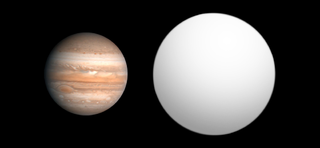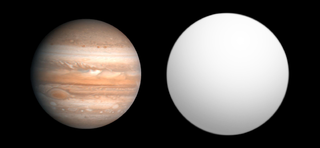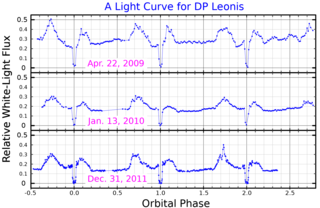Related Research Articles

OGLE-TR-122 is a binary stellar system containing one of the smallest main-sequence stars whose radius has been measured. It was discovered when the Optical Gravitational Lensing Experiment (OGLE) survey observed the smaller star eclipsing the larger primary. The orbital period is approximately 7.3 days. The system's primary is thought to resemble the Sun.
OGLE-TR-111 is a yellow dwarf star approximately 5,000 light-years away in the constellation of Carina. Having an apparent magnitude of about 17, this distant and dim star has not yet been cataloged. Because its apparent brightness changes when one of its planets transits, the star has been given the variable star designation V759 Carinae.
HD 179949 is a 6th magnitude star in the constellation of Sagittarius. It is a yellow-white dwarf, a type of star hotter and more luminous than the Sun. The star is located about 90 light years from Earth and might be visible under exceptionally good conditions to an experienced observer without technical aid; usually binoculars are needed.
OGLE-TR-132 is a distant magnitude 15.72 star in the star fields of the constellation Carina. Because of its great distance, about 4,900 light-years, and location in the crowded field it was not notable in any way. Because its apparent brightness changes when one of its planets transits, the star has been given the variable star designation V742 Carinae. The spectral type of the star is type F. A yellow-white, very metal-rich dwarf star, it is slightly hotter and more luminous than the Sun.

OGLE-TR-10b is an extrasolar planet orbiting the star OGLE-TR-10.

The Optical Gravitational Lensing Experiment (OGLE) is a Polish astronomical project based at the University of Warsaw that runs a long-term variability sky survey (1992–present). The main goals are the detection and classification of variable stars, discovery of microlensing events, dwarf novae, and studies of the structure of the Galaxy and the Magellanic Clouds. Since the project began in 1992, it has discovered a multitude of extrasolar planets, together with the first planet discovered using the transit method (OGLE-TR-56b) and gravitational microlensing. The project has been led by professor Andrzej Udalski since its inception.
OGLE-TR-56 is a dim, distant, magnitude 17 Sun-like star located approximately 1,500 parsecs away in the constellation of Sagittarius. This star is listed as an eclipsing type variable star with the eclipse due to the passage of the planet as noted in the discovery papers.

OGLE-TR-56b is an extrasolar planet located approximately 1500 parsecs or 5000 light years away in the constellation of Sagittarius, orbiting the star OGLE-TR-56. This planet was the first known exoplanet to be discovered with the transit method. The object was discovered by the OGLE project, announced on July 5, 2002 and confirmed on January 4, 2003 by the Doppler technique. The period of this confirmed planet was the shortest until the confirmed discovery of WASP-12b on April 1, 2008. The short period and proximity of the OGLE-TR-56 b to its host mean it belongs to a class of objects known as hot Jupiters.

Omicron Cassiopeiae is a triple star system in the constellation Cassiopeia. It is approximately 700 light-years from Earth, based on its parallax. It is visible to the naked eye with a slightly variable apparent magnitude of about 4.5.

HD 192310 is a star in the southern constellation of Capricornus. It is located in the solar neighborhood at a distance of 28.7 light-years, and is within the range of luminosity needed to be viewed from the Earth with the unaided eye. HD 192310 is suspected of being a variable star, but this is unconfirmed.
Gliese 86 is a K-type main-sequence star approximately 35 light-years away in the constellation of Eridanus. It has been confirmed that a white dwarf orbits the primary star. In 1998 the European Southern Observatory announced that an extrasolar planet was orbiting the star.
OGLE-TR-182 is a dim magnitude 17 star far off in the constellation Carina at a distance of approximately 12,700 light years.
OGLE-TR-211 is a distant magnitude 14 star located about 5,700 light years away in the constellation of Carina.

OGLE-TR-182b is a transiting extrasolar planet. It is a hot Jupiter with a similar mass to Jupiter but a larger radius.

OGLE-TR-113b is an extrasolar planet orbiting the star OGLE-TR-113.

OGLE2-TR-L9 is a magnitude 15 star in the constellation Carina at a distance of approximately 5,142 light years.

OGLE-TR-111b is an extrasolar planet approximately 5,000 light-years away in the constellation of Carina. The planet is currently the only confirmed planet orbiting the star OGLE-TR-111.

OGLE-TR-132b is an extrasolar planet orbiting the star OGLE-TR-132.

V429 Geminorum (BD+20°1790) is a young orange dwarf star in the constellation Gemini, located 90 light years away from the Sun. It is a BY Draconis variable, a cool dwarf which varies rapidly in brightness as it rotates.

DP Leonis is binary star system in the equatorial constellation of Leo. It is a variable star that ranges in apparent visual magnitude from 17.5 down to 19. The system is located at a distance of approximately 990 light-years from the Sun based on parallax. It is a cataclysmic variable star of the AM Herculis-type also known as polars. The system comprises an eclipsing white dwarf and red dwarf in tight orbit and an extrasolar planet. This eclipsing variable was discovered by P. Biermann and associates in 1982 as the optical counterpart to the EINSTEIN X-ray source E1114+182.
References
- 1 2 3 4 5 6 7 "SIMBAD query result: SBC9 2451 -- Spectroscopic binary". Centre de Données astronomiques de Strasbourg . Retrieved 2009-04-30.
- ↑ Samus, N. N.; Durlevich, O. V.; et al. (2009). "VizieR Online Data Catalog: General Catalogue of Variable Stars (Samus+ 2007-2013)". VizieR On-line Data Catalog: B/GCVS. Originally Published in: 2009yCat....102025S. 1. Bibcode:2009yCat....102025S.
- 1 2 3 Evans, D. F; et al. (2016). "High-resolution Imaging of Transiting Extrasolar Planetary systems (HITEP)". Astronomy and Astrophysics. 589. A58. arXiv: 1603.03274 . Bibcode:2016A&A...589A..58E. doi:10.1051/0004-6361/201527970. S2CID 14215845.
- ↑ Santos, N. C.; et al. (2006). "Chemical abundances for the transiting planet host stars OGLE-TR-10, 56, 111, 113, 132, and TrES-1". Astronomy and Astrophysics. 458 (3): 997–1005. arXiv: astro-ph/0606758 . Bibcode:2006A&A...458..997S. doi:10.1051/0004-6361:20065683. S2CID 9932745.
- ↑ Udalski, A.; et al. (2002). "The Optical Gravitational Lensing Experiment. Planetary and Low-Luminosity Object Transits in the Carina Fields of the Galactic Disk". Acta Astronomica. 52 (4): 317–359. arXiv: astro-ph/0301210 . Bibcode:2002AcA....52..317U.
- ↑ Bouchy, F.; et al. (2004). "Two new "very hot Jupiters" among the OGLE transiting candidates". Astronomy and Astrophysics. 421 (1): L13–L16. arXiv: astro-ph/0404264 . Bibcode:2004A&A...421L..13B. doi:10.1051/0004-6361:20040170. S2CID 16245079. Archived from the original on 2013-12-11. Retrieved 2013-12-07.